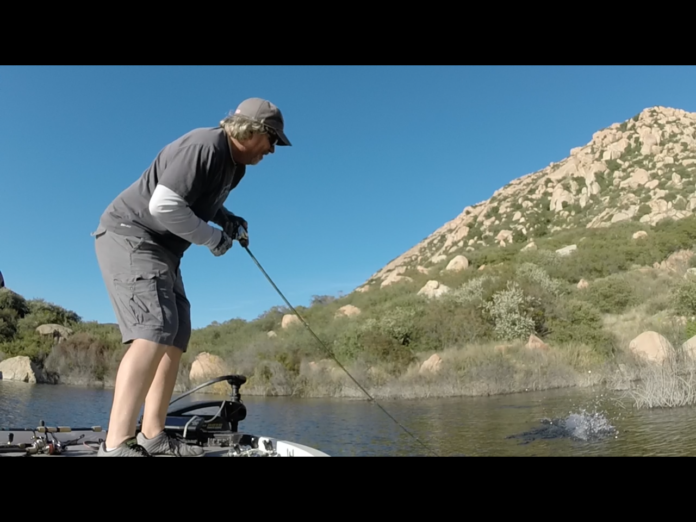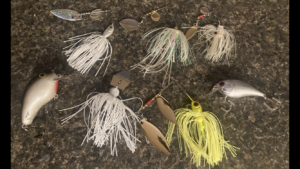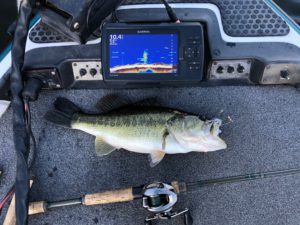
BY ROB MAGARGAL
As the weather gets colder and days get shorter, we see water temps falling weekly. From that, many of us, myself included, are doing our damnest to keep the dream alive of chasing down topwater schools that are fattening up for the winter slumber.
Still, with that, many fishermen transition to winter patterns at the first sign of a needing a jacket in the morning, they disregard the fish still trying to eat as much as they can before the winter transition really happens. They instead focus on the deep-water structure trying to get the fish that transitioned as fast as they did.
Still, all good things must end and it eventually flips that switch. Then we see lots of boats slow worming searching for those deep-water hideouts. More drop-shots are being tossed than at anytime of the year while moving into December and January in SoCal. The Ned rig becomes a go to as well, as does basically any bait that looks unassuming, easy to eat and one that can be presented easily.
Lighter line gets installed on their reels. The fishermen remove those heavy braid rods from the boat for the 8- and 6-pound braid rods as well 4 and 6-pound fluoro rods — lots of light leaders being added as well at this time of year.
Truth be told there is a good reason for it. We all know the drill or at least we should. The fish get very lethargic in the winter as the water gets colder. They are not going to search or hunt down food as they did in the summer and fall. It’s not rocket science on understanding winter fish. It’s Winter Fishing 101.

They’ll sit in key locations and lay and wait. They do not want to waste an ounce of energy chasing something down. They are looking for the easy meal. Those lightly wind-blown points with rock. Those deeper treetops or brush piles along with deeper creek channels become the back roads to a great meal.
I have found at our lakes they’ll sit belly down in the mud trying to keep warm, using the mud to insulate their bodies for whatever little heat there is down there. Those are tough fish to see on a finder, as you’ll often pass right over them as nothing there.
With that being said, even in the dead of our winter we get some nice, warm days. Santa Ana winds are very well known to happen in December. How many 85-degree Christmas’s have we seen here in SoCal over the years? That right there brings a variety of feeding patterns with many of the bass.
These halves of a degree changes in water temp in areas of the lake during Santa Ana conditions make a huge difference to the fish. It may seem relatively insignificant to us; however, to them it’s huge.
There are both shallow and deep bass all year long. That has been proven to be accurate over many studies on the behavior habits of bass. This means there are opportunities for the reaction bite in the winter. It’s not all Ned rigs and drop-shots. It’s not restricted to just Ice Jigs and spoons over schools in 60 feet.

I am personally a shallow-water bass fisherman. Yes, I have also been known to toss metal during the summer and fall, but that’s a technique-specific bite as well as a window-of-opportunity bite. I’d say about 90% of the time I’m fishing in 20 feet or less.
Getting back to those warmer days in the winter, it raises the water temps ever so slightly in many areas of the lake at various times of the day.
How many times have we been running the boat and feel both cold and warm wind within 150 yards? Or just mixing warmer water with cold? It’s a swirl of different temps until it finally equalizes.
This happens all day at the lakes all year long. It’s understanding why and when it happens that matters. And in the winter, it really matters if thinking about fishing shallow water. Remember, we’re talking a slight difference in temp. Cold-blooded animals react to the slightest change. It can make the difference of them eating or not.
Knowing there is a long cove that that has a shallow flat that extends 5 to 10 yards at the end can be huge. The water around that flat can be half a degree warmer. If there is rock there also… that’s a bonus. The rock will warm up as the day goes on. The fish will get very close to that natural heater. This happens at various times and at various locations.
I have found a huge key is having zero wind — nothing that allows the water to mix that swirl to an equalized temp. If you have wind and even light wind chop on the water, that water can be colder from having the deeper water pulled up from the wind current and chop.
If stable, this can be a great time for properly presented baits, including reaction baits.
As with many baits, sometimes downsizing is the key. One of my favorite wintertime reaction baits is the spinnerbait. It is such versatile bait that often gets overlooked in the winter. I feel it does from too many anglers having a KVD complex with this bait… Burn it on the surface. Make them strike it.
That’s great when the water is 80-plus degrees, not when its 58 degrees. In many places around the country, 58 degrees is considered warm. Not in SoCal though — 55 to 58 is very cold for our lakes. Truly frigid? 52 degrees.
This is when downsizing to ¼-ounce even a 3/16-ounce bait can be deadly on those shallow bass waiting for that easy bait to come by. If the water is stained you can go to a 3/8 without worry. That’s one of my favorite choices at El Capitan reservoir in Lakeside. That lake has so many shallow rock piles and long shallow flats with brush pile chalk all around. It’s the perfect lake for the right presentation on reaction baits.
Being able to slowly tick over the tops of the deeper stickups and allow the bait to pendulum fall into the gaps can be really fun.
When saying fishing deeper, that is a relative term here. Deeper could be 8 feet in the area being fished. Or it could be 15 feet or more, deeper to the area being fished. The gear choice changes slightly for me at this time of year also. I usually use 20 fluoro for spinnerbaits. In the winter, in stained-to-dirty bodies of water I’ll go to braided line, and 30-pound is usually my go-to. The reason is simple; the bites can be so subtle that the braid tells me every time I’ve been even touched by a fish. You can feel a fish breathe on the bait while slowly ticking over the structure.
Even in the winter with a reaction bite, it’s still a reaction bite. The line size is not really an issue. It’s all about the opportunity that just presented itself to the fish. Present the bait correctly and it’s over, you’ll get bit.
It’s all about the long cast and letting the bait sink down. After that it’s about getting those blades turning. The bait only needs to be moved fast enough to have the blade turn, and that’s it.
The style of bait I like the best is a willow leaf. It’s the softest of the blades motion wise. Its not about attracting attention to the bait like a Colorado blade would do with that heavy thump in the water. That heavy thump can push a fish away in the winter. It’s more about a slow subtle presentation that looks like a slow-moving school of bait.
Another way to preset this bait in the winter is pitching it along laydowns and brush piles. There are shallow fish, and spooky shallow fish as well… Gently pitch the bait up and slowly pull the bait along that structure. Pitching a bait like this can be very productive in the winter. Don’t go in making a bunch of noise — float in. Don’t even use the troller, just float in. Set yourself up for success. Line up the boat from a distance and move in slowly. No boat wake, no big motor noise. A stealth approach is the key. You may only get 1 maybe 2 opportunities within a 10-yard area, so make it count.
Another technique we all know of or at least have heard of is a deep crank bite in the winter.
This can also be the time for the big, slow wobble of an extremely shallow squarebill. That bait reeled slowly over the rocks bouncing off them or slowly reeled in between brush piles. That wake on the surface can be a calling card. It’s the opposite of the blade bait ticking structure below. With this one, the wobble takes center stage. It’s a slowly moved bait that does not scare them away. Don’t burn it KVD-style, slowly reel it in.
Still one of my favorites is the Fluke reeled in slowly over those shallow areas. Letting it slowly fall and then slowly reeling it in can be deadly. It’s not about the quick dart of the Fluke like in the summer or fall. It’s about the slow, lazy motion of a dying baitfish. The bite is so soft when they take it. They’ll roll on it or just lightly suck it in, not a violent smash — no crazy blowup. You may just feel it being pulled away. Set the hook if you even have a hint of a bite, as they’ll spit it fast. I like to use this technique, as an alternative to the jerkbait, mainly from being able to fish it in places you’d never toss a jerkbait.
The Fluke can also be tossed onto those remaining weeds and or the back of pockets on those steeper banks. Flip them in the tules and brush and slowly pull them off to sink down. It’s really endless how it can be used during the winter. It’s more remembering that it’s about subtle movements and not hard, fast-flash movements.
When people are going deep during the winter… there is no real need to follow that pattern. If you feel that’s the only way to go, I understand. If that’s the pattern, nail weight the Fluke. Count it down and slowly reel it over that deep structure. Texas rig it and you run it through those deep brush piles and trees without hanging up. This makes fluoro your line of choice from its sinking properties.
Once again, deeper is relative. Never forget that when you’re on the water, no matter what time of year it is.
When thinking about reaction baits, they do not have to be put away when winter hits. We just have to have a different approach to fishing them. Use them in a way that matches what the lake is presenting to you.
Pay attention to the subtle details. It is those details that separates being successful or be frustrated during your time on the water this winter.
For me, it’s the slow reaction baits. They take away the everlasting pain of worming for two months while waiting for the water to warm up, all while dreaming of the pre-spawn coming in February. It’s only a few short months away… A guy can dream, can’t he? Until then… try those properly presented reaction baits this winter — it sure beats deep worming to me.


